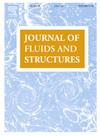An adaptive time integration approach for aeroelastic simulations using the unsteady vortex-lattice method and geometrically exact beams
IF 3.5
2区 工程技术
Q1 ENGINEERING, MECHANICAL
引用次数: 0
Abstract
In the context of aeroelastic simulations, the unsteady vortex-lattice method, strongly coupled with geometrically exact beams, represents a good balance between computational cost and accuracy. However, the computation of aerodynamic loads can still be very time-consuming. To reduce the wall time of aeroelastic computations using the unsteady vortex-lattice method and geometrically exact beams, we strive for a technique to reduce the number of time steps necessary to simulate a given physical time. This paper presents an approach to calculate and adapt the time step size, which can significantly reduce the total computation time without compromising the accuracy of the result. In order to achieve this, the time step size is adapted following the evolution of relevant physical quantities describing the system (ring circulations, aerodynamic forces, potential energy, kinetic energy). Limits for the minimum and maximum time step sizes are introduced by monitoring the geometry of the wake elements. This straightforward approach can easily be adapted to other aeroelastic frameworks using the unsteady vortex-lattice method. The high potential for computational acceleration is demonstrated in the application example of a NACA wing, the benchmark of the Pazy wing, and the NREL 5 MW reference wind turbine.
采用非定常涡格法和几何精确梁的气动弹性模拟自适应时间积分方法
在气动弹性模拟的背景下,非定常涡点阵法与几何精确梁强耦合,在计算成本和精度之间取得了很好的平衡。然而,气动载荷的计算仍然非常耗时。为了减少使用非定常涡晶格法和几何精确梁的气动弹性计算的壁时间,我们努力寻找一种技术来减少模拟给定物理时间所需的时间步长。本文提出了一种计算和调整时间步长的方法,可以在不影响结果准确性的情况下显著减少总计算时间。为了实现这一点,时间步长是根据描述系统的相关物理量(环循环、气动力、势能、动能)的演变而调整的。通过监测尾迹元件的几何形状,引入了最小和最大时间步长限制。这种简单的方法可以很容易地应用于其他气动弹性框架的非定常涡点阵方法。在NACA机翼、Pazy机翼的基准和NREL 5mw参考风力涡轮机的应用实例中,证明了计算加速的高潜力。
本文章由计算机程序翻译,如有差异,请以英文原文为准。
求助全文
约1分钟内获得全文
求助全文
来源期刊

Journal of Fluids and Structures
工程技术-工程:机械
CiteScore
6.90
自引率
8.30%
发文量
173
审稿时长
65 days
期刊介绍:
The Journal of Fluids and Structures serves as a focal point and a forum for the exchange of ideas, for the many kinds of specialists and practitioners concerned with fluid–structure interactions and the dynamics of systems related thereto, in any field. One of its aims is to foster the cross–fertilization of ideas, methods and techniques in the various disciplines involved.
The journal publishes papers that present original and significant contributions on all aspects of the mechanical interactions between fluids and solids, regardless of scale.
 求助内容:
求助内容: 应助结果提醒方式:
应助结果提醒方式:


